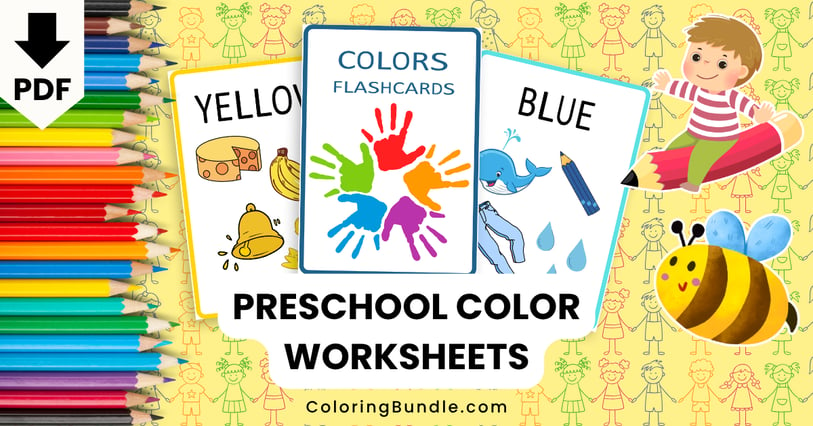The Complete Guide to Preschool Color Worksheets: Developing Young Minds Through Color


As early childhood educators, we understand that color recognition isn't just about knowing the difference between red and blue—it's a fundamental building block for cognitive development, language acquisition, and even early math skills. When I first started teaching preschoolers 12 years ago, I quickly discovered that color worksheets were among the most versatile teaching tools in my classroom.
Why Color Recognition Matters in Early Childhood
Before diving into worksheets, let's understand why color learning is so crucial. According to child development experts at Harvard University's Center on the Developing Child, visual discrimination skills like color recognition help build neural pathways that support reading readiness and pattern recognition.
Children typically begin distinguishing colors around 18 months, but mastery often doesn't occur until age 3-4. This makes the preschool years the perfect window for intentional color instruction through engaging worksheets and activities.
Types of Color Worksheets That Actually Work
After years in the classroom, I've found these worksheet categories to be most effective:
1. Color Identification Worksheets
These foundational worksheets help children recognize and name colors. The most effective versions:
Present one color at a time before introducing multiple colors
Pair colors with familiar objects (red apple, blue sky)
Include both the color word and a color swatch
Research from the National Association for the Education of Young Children suggests that repeated exposure to color names in meaningful contexts significantly improves retention.
2. Color Matching Activities
These worksheets develop visual discrimination and cognitive skills:
Match identical colored objects
Connect colored items to their corresponding color word
Sort objects by color family (light blue/dark blue)
One of my favorite activities involves matching colored mittens—children love the practical connection to their own winter gear!
3. Color Sorting Worksheets
Sorting activities develop critical thinking and classification skills:
Sort objects by color into corresponding buckets
Categorize multicolored objects by their dominant color
Group objects by color families (warm vs. cool colors)
A 2023 study from the Journal of Educational Psychology found that color sorting activities significantly improved preschoolers' ability to categorize information in other contexts as well.
4. Color and Fine Motor Integration
The most effective worksheets combine color learning with fine motor development:
Trace color words with corresponding colored crayons
Color within increasingly complex boundaries
Use dot markers on color-specific targets
Pro tip: Try using broken crayons rather than whole ones! This naturally encourages the tripod grasp that builds proper handwriting skills.
Implementing Color Worksheets Effectively
As any preschool teacher knows, even the best worksheets fall flat without proper implementation. Here's how to maximize their effectiveness:
Create a Supportive Environment
Ensure good lighting so colors appear true
Minimize visual distractions during color activities
Use consistent color language across activities ("sky blue" vs. just "blue")
Position worksheets at eye level or on vertical surfaces to promote proper posture
Extend Learning Beyond the Worksheet
The most successful color learning happens when worksheets are part of a comprehensive approach:
Follow up worksheet time with hands-on color hunts around the classroom
Create color-themed sensory bins that reinforce worksheet concepts
Use color songs and rhymes to cement learning (Colorful World offers excellent resources)
Incorporate color mixing experiments for older preschoolers
Adapt for Different Learning Styles
Effective teachers know that worksheets must be adapted for diverse learners:
For tactile learners: Add texture to worksheet borders with glue
For active learners: Turn worksheets into movement games ("hop to all the blue shapes")
For visual learners: Ensure high contrast between colors and backgrounds
For children with color vision deficiencies: Pair colors with symbols or patterns
Developmental Progression of Color Learning
Understanding the typical progression of color learning helps us choose age-appropriate worksheets:
Ages 2-3:
Focus on primary colors (red, blue, yellow)
Use simple, bold images with minimal distractions
Limit choices to 2-3 colors at a time
Ages 3-4:
Introduce secondary colors (green, orange, purple)
Begin color matching across different objects
Add simple color words for recognition
Ages 4-5:
Explore color shades and tints
Introduce color mixing concepts
Incorporate color words into early literacy activities
Addressing Common Challenges
Even with excellent worksheets, you may encounter some challenges:
Color Confusion: If a child consistently confuses certain colors (often blue/green or red/orange), try teaching these colors separately before presenting them together. The American Academy of Pediatrics recommends screening for color vision deficiencies if confusion persists.
Worksheet Resistance: Some children simply don't enjoy worksheets! For these learners, try:
Laminating worksheets for use with dry-erase markers
Turning worksheets into collaborative games
Using digital versions on classroom tablets
Incorporating movement breaks between worksheet activities
Limited Attention Spans: Keep worksheet sessions brief (5-10 minutes) and alternate with more active learning. Research from ZERO TO THREE confirms that young children learn best through varied, multi-sensory experiences.
Measuring Progress and Celebrating Success
How do we know if our color worksheets are working? Look for these indicators:
Spontaneous color naming during play
Transfer of color knowledge to new contexts
Increased confidence in color identification
Growing interest in colors in the environment
Remember to celebrate progress! Create a "color expert" certificate or a special display area for completed color work.
Beyond Basic Colors: Where to Go Next
Once children master the basic colors, extend their learning with:
Color mixing worksheets and experiments
Cultural connections to color meanings around the world
Color and emotion exploration
Integration of colors with shapes, numbers, and letters
The International Color Consortium offers fascinating insights into how color perception develops across cultures—a wonderful resource for expanding color education.
Conclusion: The Lasting Impact of Color Learning
While color worksheets might seem simple, they build crucial cognitive foundations. When implemented thoughtfully, they contribute to visual discrimination, vocabulary development, classification skills, and even artistic expression.
As early childhood educators, we know that these seemingly small learning moments—distinguishing between crimson and scarlet, noticing how colors change in different lights—are actually building the observational skills and cognitive flexibility our students will use throughout their lives.
Subscribe to our newsletter
Enjoy exclusive special deals available only to our subscribers.
